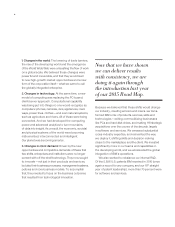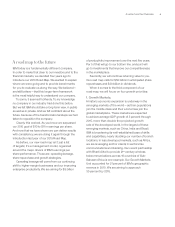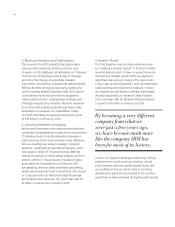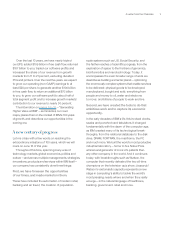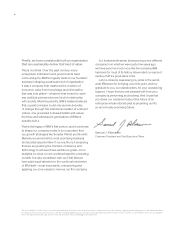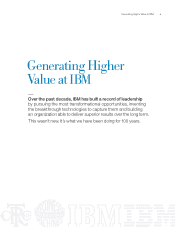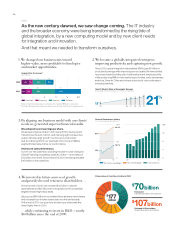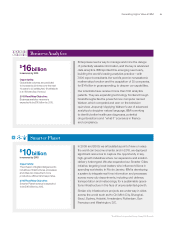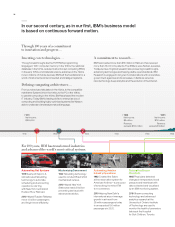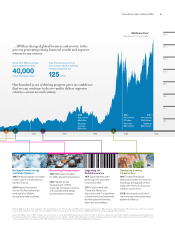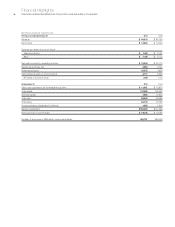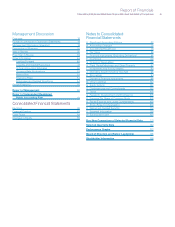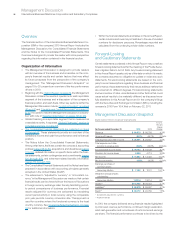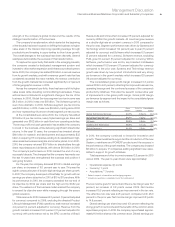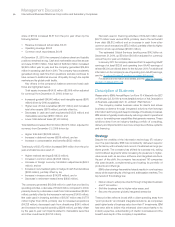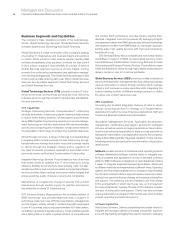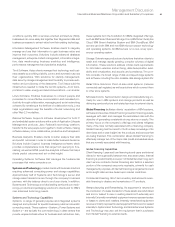IBM 2010 Annual Report Download - page 16
Download and view the complete annual report
Please find page 16 of the 2010 IBM annual report below. You can navigate through the pages in the report by either clicking on the pages listed below, or by using the keyword search tool below to find specific information within the annual report.
1920 1930 1940 1950 19601910
Raising Healthcare
Standards
1965 Physicians detected
changes in temperature, blood
pressure and heartbeat with
data collected and visualized
by an IBM monitoring system.
2010 Stream computing
technology and advanced
analytics research at the
University of Ontario Institute
of Technology are used to
monitor the health of premature
babies at the Hospital
for Sick Children, Toronto.
In our second century, as in our first, IBM’s business model
is based on continuous forward motion.
For 100 years, IBM has transformed industries
and advanced the world’s most critical systems.
Automating Rail Systems
1915 Nearly all major U.S.
railroads used tabulating
technology to automate
scheduling and accounting
operations, starting
with New York Central and
Hudson River Railroad.
2010 Helped Russian Railways
move 1.3 billion passengers
and freight more efficiently.
Modernizing Government
1922 Tabulating technology
used to conduct Brazil’s first
mechanized census.
2010 Helped New York
State save nearly $1 billion
preventing tax fraud with
advanced analytics.
Automating Aviation
Industry Operations
1962 Created the Sabre
airline reservation system for
American Airlines—a precursor
of everything from the ATM
to e-commerce.
2010 Helping New Delhi’s
international airport manage
growth in air travel from
28 million passengers today
to an expected 150 million
passengers in 2020.
1957 •
Net income:
$110 million
Revenue:
exceeds $1 billion
• 1943
Net income:
$9 million
Revenue:
exceeds $100 million
• 1911
Net income:
$800,000
Inventing core technologies …
Through breakthroughs like the FORTRAN programming
language in 1957, computer memory in the 1960s, the relational
database in the 1970s, reduced instruction set computing (RISC)
in the early 1980s, and materials science advances in the 1990s
(now in millions of mobile devices), IBM built the foundations for a
world of instrumented, interconnected and intelligent systems.
Defining computing architectures …
From punched card tabulators in the 1920s, to the compatible
mainframe System/360 in the 1960s, to the PC in the 1980s,
to parallel computing in the 1990s, IBM has shaped the modern
IT industry. Today IBM is leading shifts to enterprise cloud
computing and building highly optimized systems like Watson
able to understand and analyze natural language.
A commitment to research …
IBM has invested more than $150 billion in R&D, and has received
more than 75,000 U.S. patents. Five IBMers were Nobel Laureates.
Today we have 10 global research labs pioneering breakthroughs,
advancing technologies and helping define open standards. IBM
Research is engaged in long-term collaborations with universities,
government agencies and businesses, in fields as varied as
nanotechnology, deep analytics and the evolution of the Internet.
Through 100 years of a commitment
to innovation and progress …
14


